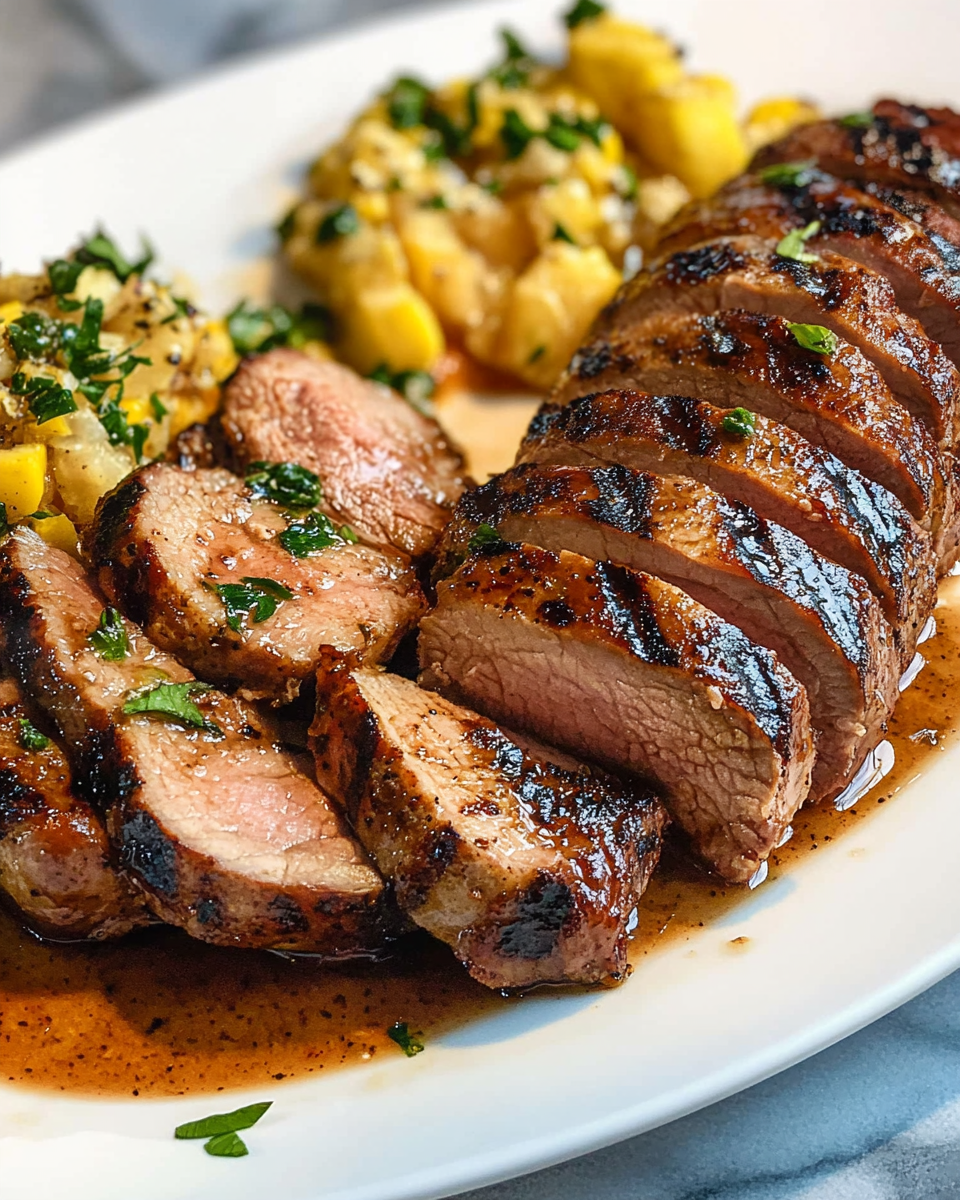A flavorful and easy-to-make dish, these grilled beef kebabs are perfect for summer cookouts or weeknight dinners. Marinated with a savory blend of herbs and spices, the beef becomes tender and juicy, while the vegetables add a delicious char and crunch.
FULL RECIPE
Ingredients
- 1½ pounds beef sirloin, cut into 1½-inch cubes
- 1 red bell pepper, cut into chunks
- 1 green bell pepper, cut into chunks
- 1 red onion, cut into wedges
- 2 tablespoons olive oil
- 2 tablespoons soy sauce
- 1 tablespoon Worcestershire sauce
- 2 garlic cloves, minced
- 1 teaspoon dried oregano
- 1 teaspoon smoked paprika
- Salt and black pepper to taste
- Metal or soaked wooden skewers
Directions
- In a large bowl, combine olive oil, soy sauce, Worcestershire sauce, garlic, oregano, paprika, salt, and pepper.
- Add the beef cubes and toss to coat evenly. Cover and marinate in the refrigerator for at least 1 hour.
- Preheat the grill to medium-high heat.
- Thread beef, bell peppers, and onion alternately onto skewers.
- Grill kebabs for 8–10 minutes, turning occasionally, until beef is cooked to your desired doneness and vegetables are slightly charred.
- Remove from grill and let rest for 5 minutes before serving.
Nutritional Information
- Calories: 280 per serving
- Protein: 28g
- Fat: 15g
- Carbohydrates: 6g
- Fiber: 1.5g
- Sodium: 480mg
The History and Origin of Beef Kebabs
Beef kebabs have a rich history that spans many cultures and centuries. Originating from Middle Eastern and Central Asian regions, kebabs were traditionally cooked over open flames or hot coals. This method of cooking beef on skewers allowed for even heat distribution and imparted a smoky flavor. Over time, kebabs spread globally and became a popular dish in Mediterranean, South Asian, and Western cuisines, adapting to local spices and ingredients.
Choosing the Right Cut of Beef for Kebabs
Selecting the right cut of beef is crucial for tender and flavorful kebabs. Cuts like sirloin, ribeye, or tenderloin are preferred because they balance tenderness with enough fat to keep the meat juicy during grilling. Tougher cuts can also be used but require longer marinating or slow cooking to soften the fibers.
Marinades and Their Role in Flavor and Tenderness
Marinades are essential in enhancing both the taste and texture of beef kebabs. Acidic components such as lemon juice, vinegar, or yogurt help break down the muscle fibers, making the meat tender. Herbs, spices, and oils in the marinade infuse the beef with deep, complex flavors that develop during the grilling process.
The Science Behind Grilling Kebabs
Grilling beef kebabs over high heat causes the Maillard reaction, a chemical reaction between amino acids and reducing sugars that gives browned food its distinctive flavor. The direct heat sears the meat, locking in juices, while the vegetables char slightly, adding smoky notes and texture contrast.
Vegetables That Complement Beef Kebabs
Bell peppers and onions are classic choices for kebabs because they grill well and provide a sweet, slightly charred flavor that pairs beautifully with beef. Other popular vegetables include cherry tomatoes, zucchini, mushrooms, and even pineapple, each adding unique flavors and textures to the dish.
Using Skewers: Metal vs. Wooden
Metal skewers are reusable and conduct heat, helping cook the meat from the inside as well. Wooden skewers need to be soaked before use to prevent burning and are typically more disposable but easier to handle. The choice depends on convenience, cooking style, and personal preference.
Tips for Properly Threading Kebabs
Threading kebabs evenly allows for consistent cooking. Avoid packing ingredients too tightly to allow heat circulation. Alternating meat and vegetables creates a balanced bite and adds visual appeal, enhancing the overall dining experience.
How to Achieve the Perfect Doneness
Cooking time depends on skewer size and grill temperature. For medium-rare beef kebabs, aim for an internal temperature of about 135°F (57°C), while medium should reach 145°F (63°C). Using a meat thermometer ensures accuracy and prevents overcooking.
Common Mistakes to Avoid When Making Beef Kebabs
Overcrowding the grill can cause uneven cooking and steaming rather than grilling. Not marinating long enough can lead to tough meat, while excessive marinating might break down the texture too much. Using very lean cuts without added fat can result in dry kebabs.
Serving Suggestions for Beef Kebabs
Beef kebabs pair well with a variety of side dishes like rice pilaf, couscous, grilled flatbread, or fresh salads. Sauces such as tzatziki, chimichurri, or garlic yogurt enhance the flavor profile and add moisture to the dish.
Health Benefits of Grilling Beef Kebabs
Grilling is a healthier cooking method because it allows excess fat to drip away from the meat, reducing calorie content. Additionally, the use of fresh vegetables adds vitamins, minerals, and dietary fiber, making beef kebabs a balanced and nutritious meal.
Spice Variations Around the World
Different cultures season beef kebabs with unique spice blends. Middle Eastern versions might use cumin, coriander, and sumac; Indian kebabs often include garam masala, turmeric, and chili; Mediterranean styles favor oregano, rosemary, and garlic. These variations showcase kebabs’ versatility.
The Importance of Resting Meat After Grilling
Allowing kebabs to rest for a few minutes after grilling lets the juices redistribute throughout the meat, enhancing tenderness and flavor. Cutting into hot meat immediately can cause the juices to escape, leading to drier results.
Kebabs for Special Diets
Beef kebabs can be adapted for low-carb or keto diets by focusing on meat and low-carb vegetables. For gluten-free needs, ensure sauces and marinades are free of wheat-based ingredients. This makes them suitable for a variety of dietary preferences without compromising taste.
Pairing Kebabs with Wine and Beverages
Robust red wines like Cabernet Sauvignon, Malbec, or Syrah complement the rich, smoky flavors of beef kebabs. For a non-alcoholic option, iced tea with lemon or sparkling water with herbs offers a refreshing balance.
Outdoor Cooking and Social Aspects
Grilling kebabs outdoors is often a social event, bringing people together for casual gatherings or celebrations. The interactive nature of grilling and sharing food enhances community bonds and creates memorable dining experiences.
Storage and Reheating Tips
Leftover beef kebabs should be stored in an airtight container in the refrigerator and consumed within 2–3 days. To reheat, use a grill or oven to maintain texture and avoid drying out, rather than microwaving.
Environmental Impact of Grilling
Grilling over charcoal or gas has different environmental footprints. Charcoal grilling produces more carbon emissions but imparts a distinct flavor. Using natural gas or electric grills can be more eco-friendly, though flavor differences exist.
Innovative Kebabs: Beyond Traditional Ingredients
Modern kebabs experiment with fusion ingredients such as exotic spices, fruits like mango or pomegranate seeds, or different protein options like plant-based beef alternatives. These innovations keep the classic dish fresh and exciting.
Cultural Celebrations Featuring Kebabs
In many cultures, kebabs are central to festivals and celebrations, symbolizing hospitality and communal joy. For example, during Ramadan in Middle Eastern countries, kebabs often appear in iftar meals to break the fast with flavorful and satisfying dishes.
Conclusion
Beef kebabs are much more than just grilled meat on skewers; they represent a culinary tradition rich in history, flavor, and cultural significance. Their versatility allows for endless creativity in ingredients and preparation methods, making them a beloved dish worldwide. Understanding the science of grilling, the importance of marinades, and thoughtful pairing enhances both the cooking process and the dining experience. Whether enjoyed at a backyard barbecue or a festive gathering, beef kebabs deliver satisfying, flavorful meals that bring people together and celebrate the joy of food.






